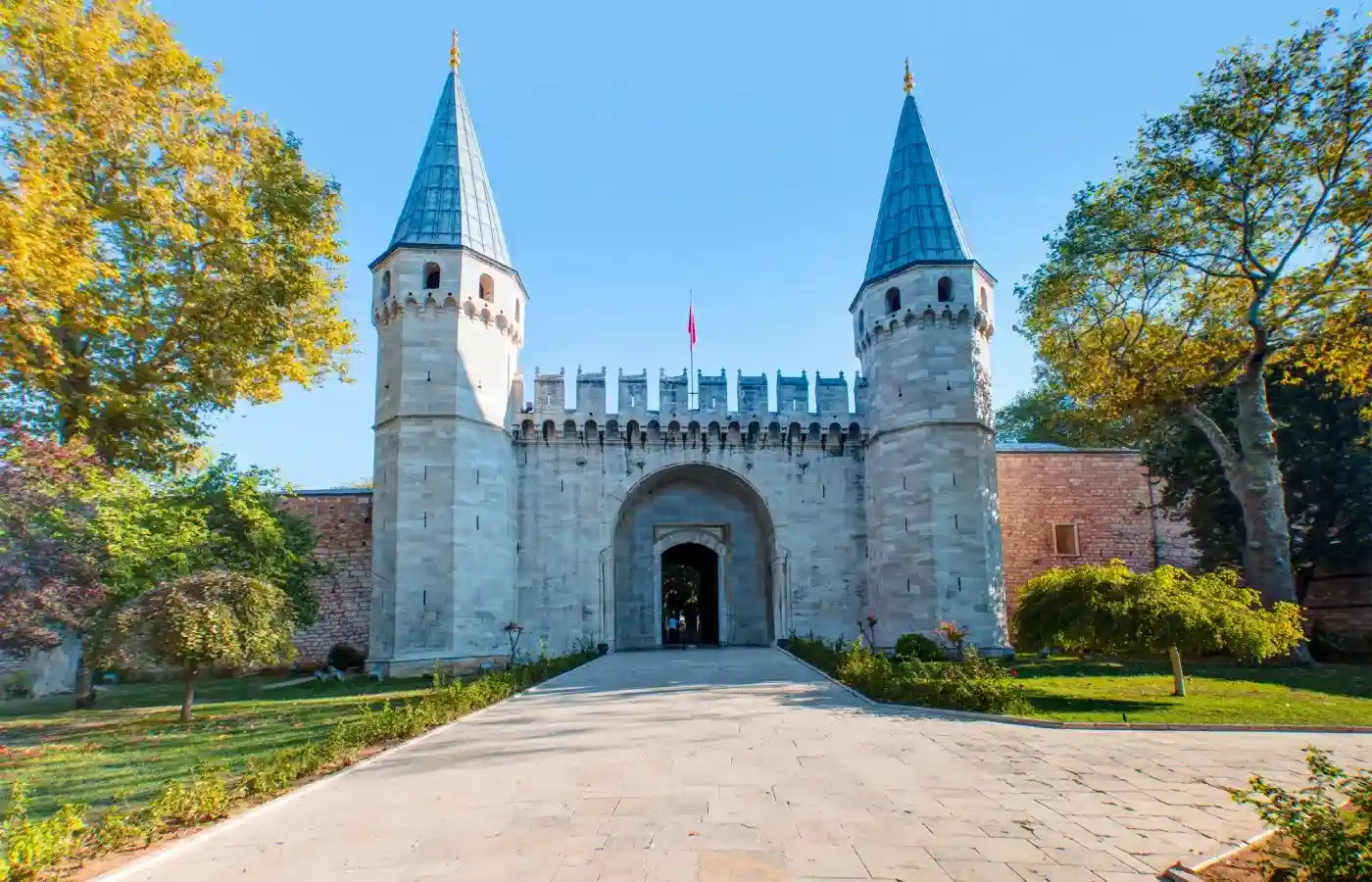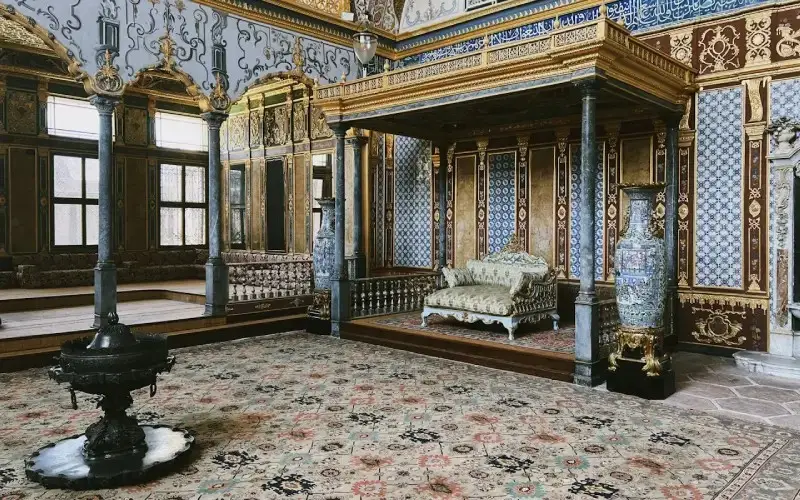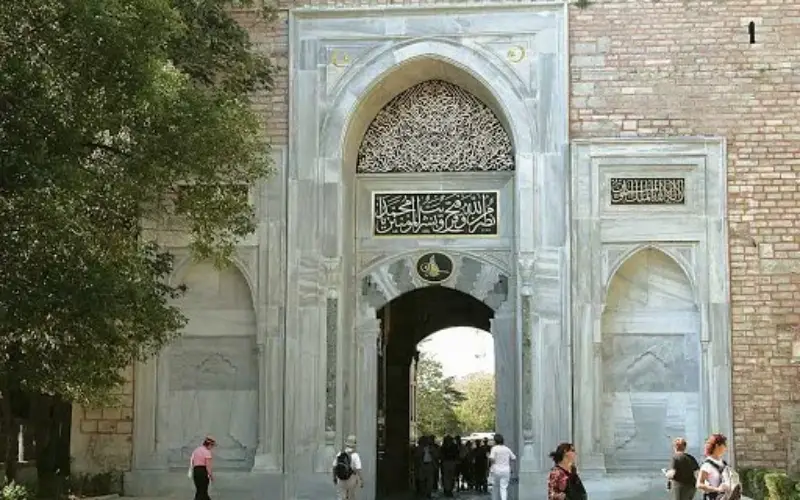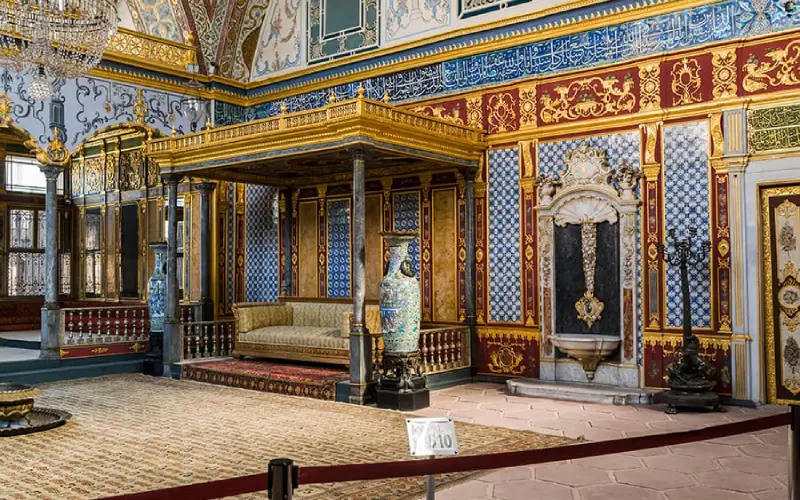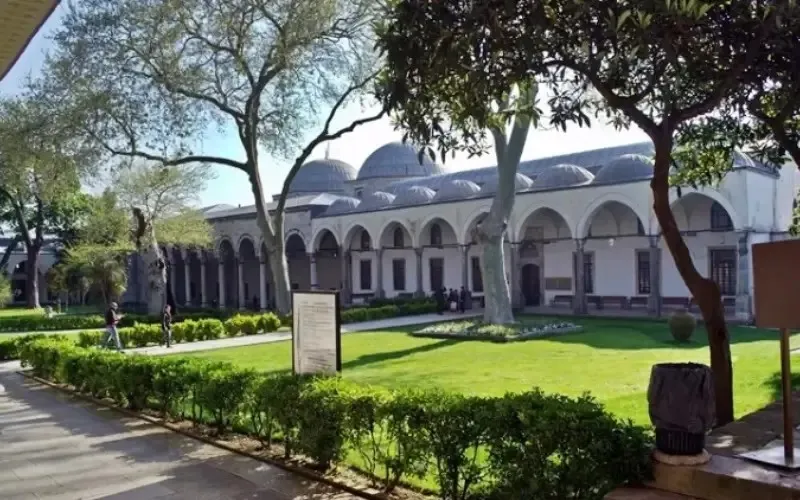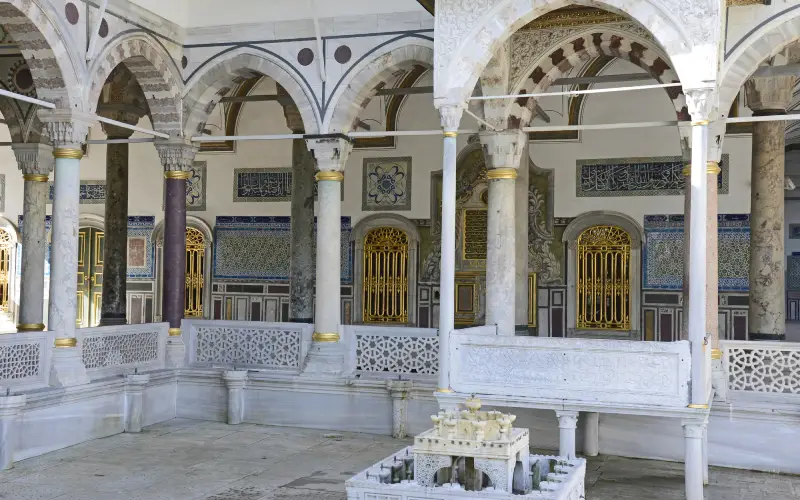Istanbul in Turkey was the center of the Ottoman Empire, and at the heart of it all was the Topkapi Palace. Built by Sultan Mehmed II in 1459, it was the royal palace of the Ottoman Sultans for 400 years till the rule of the 31st Sultan. The original design underwent several expansions and renovations over the years, especially during the rule of Sultan Suleiman, the Magnificent. In the 19th century, the palace was turned into a museum and today, it is one of the main cultural and historical landmarks of Istanbul. A part of almost all Istanbul holiday packages, here we give you a peek inside this palatial structure.
What to See Inside Topkapi Palace?
The magnificent Topkapi Palace covers an area of 700,000 square meters and consists of four main courtyards and several smaller courtyards with huge walls. Apart from one and two-storied buildings, this palace includes beautiful gardens, a Harem, and numerous pavilions. The architecture of the palace has Ottoman, Byzantine, Islamic, and European influences, giving it a unique appearance.
Different parts of the palace were used for various purposes. Apart from strolling around the various sections of the palace, you can also visit the museum, where you will get to know more about Ottoman history through the different exhibits. Let us look at the interesting things and places you can check out inside Topkapi Palace.
The First Courtyard
Image Credit : palacetopkapi.com
The largest of the four courtyards of the Topkapi Palace, the first courtyard held political and administrative importance during the Ottoman rule. Also known as the Janissaries Court and the Parade Court, the First Courtyard is where the court officials, janissaries, and elite soldiers would come together for the convening of the imperial council. This courtyard was also open to the public, as this is where the administrative activities and state functions were conducted. The architecture of this courtyard is a combination of Ottoman and Byzantine styles. It is adorned with high walls and was used as an external park.
The Imperial Gate: This large and magnificent gate is your entrance into the Topkapi Palace. The Imperial Gate was built in 1478, although the facade of the gate was covered with marble in the 19th century. Still, you can see verses from the Quran and Tughras of the Sultans inscribed in Ottoman calligraphy on this gate.
The Garden: The First Courtyard is home to a spacious, beautiful garden filled with different types of plants, trees, and flowers. It is the perfect place to stroll around before or after the tour of the palace.
Hagia Irene: Hagia Irene, the oldest Christian orthodox church in the city, is located inside the first courtyard of the Topkapi Palace. This church was built in the 4th century, although it was used as a warehouse for storing arsenal and weapons during the Ottoman rule. Today, it has been converted into a museum, which requires a separate ticket to visit. But Hagia Irene is the most popular as a music concert hall due to its amazing acoustics.
Fountains: Another prominent feature of the First Courtyard is the fountains that adorn the garden. Among all the fountains you find here, the most popular is the Executioner’s Fountain. It is believed that the executioner used to wash his hands as well as his sword after every execution in this fountain.
The Second Courtyard
Image Credit: iamistanbul.com
The Second Courtyard, also known as the Divan Court, of the Topkapi Palace takes you further into the palace structure. The Gate of Salutation is the door that takes you to the second courtyard from the first one. The main significance of this courtyard is that while the first one was open to the public, the second one is more private. The space is home to the Imperial Council, where important decisions about the empire were made. The Outer Imperial Treasury is also located in this courtyard. You will also find the royal kitchens here. This courtyard has several museums, where you will get to glimpse into the regality of the Ottoman Empire as well as the Topkapi Palace history.
Imperial Council Chamber: Situated at the northwest corner of the courtyard, The Imperial Council is a three-domed chamber where the major governing decisions were made. It is here that the Grand Vizier and other council members convened. The original chamber was constructed by Sultan Mehmed II, although the one you see today was built by Sultan Suleiman I. You can enter this rococo style building using several entrances. Do check out its wooden ceiling, which is white and green in color embedded with gold motifs.
Palace Kitchens: A noteworthy feature of the second courtyard is the Palace Kitchens. Built in the 15th century, it was expanded and reconstructed during the reign of Sultan Suleyman, the Magnificent and later after a major fire. Known to be the largest kitchen in the Ottman Empire, this kitchen is divided into 10 buildings. More than 800 people worked in these kitchens, and almost 4000 people were fed here every day, including the royal family and the staff. A visit to the kitchen section of the palace would give you the chance to see the kitchen utensils of the Ottoman Era.
Arms Collection: The Arms Collection section houses more than 400 weapons, mostly belonging to the Ottoman period, although you will see arms right from the 7th century here. While the arms during the Ottoman Empire are dominant, this museum is considered to have the largest collections of Islamic arms in the world. Apart from the Ottoman weapons, you will also find arms from the Abbasid and Umayyad dynasties here along with European and Asian weapons.
Porcelain Collection: The Porcelain Collection is one that needs special mention. Along with the kitchen utensils, the Kitchens of the Topkapi Palace also showcase silver collection and large collection of porcelain wares. A major portion of them is Chinese porcelain, believed to be gifts from Chinese emperors during the Ottoman convoy visits to China. Porcelain belonging to different Chinese dynasties can be seen here. Apart from this, you will see quite a significant collection of Japanese and European porcelain as well.
Tower of Justice: Located right next to the Imperial Council Chamber, the Tower of Justice is the tallest tower of the Topkapi Palace and is considered a landmark that can be seen from the Bosphorous. It includes a small room through which the Sultan could listen to the meetings of the council without being noticed. It is covered with a veiled window, facing the council chamber.
 Featured
Featured  Featured
Featured  Featured
Featured The Third Courtyard
Image Credit: topkapi-palace.net
The Gate of Felicity in the second courtyard takes you to the Third Courtyard, which is also called the Inner Palace. This is the private residence of the King and also includes the Harem, the Privy Chamber, and the Treasury. The layout of this courtyard was designed during the time of Sultan Mehmed II.
Topkapi Palace Harem: The Harem is the most interesting section of this courtyard of the palace. Consisting of more than 400 rooms, the harem is where the royal family, including the Sultan, his mother, wife, concubines, children, and servants lived. The Harem has numerous structures, all interconnected by courtyards and hallways. Some of the sections of the harem include Harem main entrance, Imperial Hall, Courtyard of the Queen Mother, Apartments of the Queen Mother, Baths of the Sultan and the Queen Mother, Courtyard of the Sultan’s Consorts and the Concubines, Courtyard of the Favorites, and more. The Harem was a crucial part of the Ottoman Empire, as it determined the continuity of the dynasty.
The Imperial Treasury: The Imperial Treasury is located inside the Conqueror’s Pavilion, built in the 15th century. A visit to this part of the palace will give you the chance to see and appreciate the heirlooms, jewelry, and artworks from the Ottoman period. Several important relics like the Sultan Mustafa III’s suits of armor, the Spoonmaker’s Diamond, Sultan Mahmud I’s throne, and the Topkapi Dagger can be seen in the treasury.
Audience Chamber: The Audience Chamber is an administrative building that you will see as soon as you enter the courtyard through the Gate of Felicity. Built in the 16th century, it was here that the Sultan had councils with his Vazir, foreign ambassadors, and other important officials. The architecture of the building is adorned by blue, white, and turquoise tiles. You will also get to see the Sultan’s main throne in this building. Sitting up in an elevated stage, it is decked with a gold and brocade cloth with pearl, ruby, and emerald plaques embedded in it.
Miniature and Portrait Gallery: Spread across two levels, the Miniature and Portrait Gallery is right next to the Imperial Treasury. Here you will find a great collection of calligraphy and miniatures. The most precious exhibit here is the hand-painted and hand-written collection of Qurans from the 12th to the 17th centuries. The gallery also showcases a 4th century Bible written in Arabic. Another invaluable part of this gallery is the first world map made by Piri Reis, a Turkish Admiral in the 16th century. On the upper floor of the gallery, you will find portraits of the sultans of the Ottoman Empire.
Mosque of the Agas: Built in the 15th century, the Mosque of the Agas is the oldest as well as the largest mosque inside the Topkapi Palace. During the Ottoman rule, the mosque was used for prayers by the Sultan, the Agas, and the pages as well. But in the 19th century, it was converted into a library. The place today holidays more than 13,500 book collections in a variety of languages like Turkish, Persian, Greek, Arabic, and more.
Privy Chamber: The Privy Chamber was constructed during Sultan Murad III’s rule, who used it as his palace office. Today, the chamber is home to the Chamber of Sacred Relics, a collection of relics that when Muslims consider to be the most sacred. Here you will get to see the Staff of Moses the first four Caliphs, a carpet of the daughter of Mohammed, and the turban of Joseph. Muslims across the world visit this place, as a part of a pilgrimage.
Dormitory of the Expeditionary Force: If you want to peek into the dressing style of the Sultans of the Ottoman Empire, a visit to the Dormitory of the Expeditionary Force is a must. Located behind the Audience Chamber, here you will get to see the royal garments of the Sultan, including his silver and gold embroidered kaftans and imperial robes.
Enderun Library: Also known as the Library of Sultan Ahmed III, the Enderun Library is completely made of marble and is a fine example of the Ottoman architecture of the 18th century. While you explore the library, you will get to see several cabinets full of books in different languages and subjects. Another special feature of this library is the large drinking fountain, situated under the portico’s central arch.
An important part of this courtyard is the Quarters of the Agas. The page boys in the service of the Sultan resided here. These boys were tutored in various arts, including painting, calligraphy, music, and more. The best of these boys would be given high-ranking posts.
The Fourth Courtyard
Image Credit : global-geography.org
The Fourth Courtyard was once a part of the third courtyard but was separated for ease of better identification. It is also one of the most beautiful sections of the palace, filled with leisure pavilions, beautiful, landscaped gardens, and terraces. This courtyard has plenty of unique and interesting attractions, making it worth a visit.
Circumcision Room: The circumcision room is a blue-tiled rectangular room with floral motifs. It was used for circumcision the young princes, an important ritual in Islam. The room is symmetrically proportioned and is adorned with tiny fountains. It was believed to have been built in the 17th century.
Yerevan Kiosk: This is an octagonal pavilion that was used for 40-day religious retreat. The specialty of Yerevan Kiosk is its lavish interiors adorned with Iznik tiled and marble walls. The interiors are decked with wooden shutters embedded with pearls, gold-leaf hand-drawn patterns, and a copper fireplace.
Baghdad Kiosk: Similar to the Yerevan Kiosk is the Baghdad Kiosk built in the 17th century. This kiosk was built to celebrate the Baghdad Campaign conducted by Sultan Murad IV. This structure has all the Ottoman architectural elements, including painted ceiling, colorful ties, tortoise shell and mother-of-pearl inlay, a silver grill, a fireplace, and lots more.
Iftar Kiosk: Also known as Iftar Pavilion or Iftar Bower, this kiosk has a cradle vault with a gilded roof. What makes this kiosk different from the other structures in the palace is that this a place where you can see Ottoman architecture influenced by that of India and China. The specialty about Iftar Kiosk is that it is here where the Sultan broke his fast during the month of Ramadan. Today, tourists flock to this place, as it gives you an incredible view of the Golden Horn, making it the perfect spot for pictures.
Terrace Kiosk: Built as a belvedere in the 16th century and reconstructed in Rococo style in the 18th century, the Terrace Kiosk is also known as the Kiosk of the Kara Mustafa Pasha. The Terrace Kiosk is made of a main hall and a prayer room along with a room filled with sweet fruit beverages. It was used by the Sultan to watch sporting and other events happening down in the garden.
A few other features that you should not miss at the Fourth Courtyard are the Terrace Mosque, Grand Kiosk, Stone Throne, Tower of the Head Tutor or the Chamber of the Chief Physician, and the beautiful outer gardens.
Conclusion
The Topkapi Palace is colossal, impressive, regal, and opulent. It will take you back to the time when the Ottomans ruled the city. So, do not miss the chance to visit this illustrious palace during your visit to Istanbul. If you are visiting this Turkish city, check out the 3-days Istanbul itinerary for a memorable holiday.
